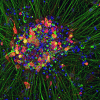New era of personalised epilepsy management
- PMID: 33037001
- PMCID: PMC7541035
- DOI: 10.1136/bmj.m3658
New era of personalised epilepsy management
Abstract
The trial and error approach to epilepsy treatment has not changed for over a century but machine learning and patient derived stem cells promise a personalised and more effective strategy, argue Patrick Kwan and colleagues
Conflict of interest statement
Competing interests: We have read and understood BMJ policy on declaration of interests and have the following interests to declare: ZC is supported by an early career fellowship from the National Health and Medical Research Council (NHMRC) of Australia (GNT1156444). PK is supported by a Medical Research Future Fund (MRFF) from the NHMRC of Australia (MRF1136427). PK and BR are supported by a MRFF Stem Cell Therapies grant (APP1201781). His institution has received speaker or consultancy fees and/or research grants from Biscayne, Eisai, GW Pharmaceuticals, LivaNova, Novartis, UCB Pharma and Zynerba. TOB is supported by a programme grant from the NHMRC of Australia (APP1091593), and the Royal Melbourne Hospital Neuroscience Foundation. AAB, AA, YM, ZG, and XW report no conflicts of interest. Provenance and peer review: Commissioned; externally peer reviewed.
Figures


References
MeSH terms
LinkOut - more resources
Full Text Sources
Medical
